Nomenclature
Tens of thousands of galaxies have been catalogued, but only a few have well-established names, such as the Andromeda Galaxy, theMagellanic Clouds, the Whirlpool Galaxy, and the Sombrero Galaxy. Astronomers work with numbers from certain catalogues, such as theMessier catalogue, the NGC (New General Catalogue), the IC (Index Catalogue), the CGCG (Catalogue of Galaxies and of Clusters of Galaxies), the MCG (Morphological Catalogue of Galaxies) and UGC (Uppsala General Catalogue of Galaxies). All of the well-known galaxies appear in one or more of these catalogues but each time under a different number. For example, Messier 109 is a spiral galaxy having the number 109 in the catalogue of Messier, but also codes NGC3992, UGC6937, CGCG 269-023, MCG +09-20-044, and PGC 37617.
Observation history
The realization that we live in a galaxy which is one among many galaxies, parallels major discoveries that were made about the Milky Way and other nebulae.
Milky Way
The Greek philosopher Democritus (450–370 BCE) proposed that the bright band on the night sky known as the Milky Way might consist of distant stars.[17] Aristotle (384–322 BCE), however, believed the Milky Way to be caused by "the ignition of the fiery exhalation of some stars that were large, numerous and close together" and that the "ignition takes place in the upper part of the atmosphere, in the region of the World that is continuous with the heavenly motions."[18] The Neoplatonist philosopher Olympiodorus the Younger (c. 495–570 CE) was critical of this view, arguing that if the Milky Way is sublunary (situated between Earth and the Moon) it should appear different at different times and places on Earth, and that it should have parallax, which it does not. In his view, the Milky Way is celestial.[19]
According to Mohani Mohamed, the Arabian astronomer Alhazen (965–1037) made the first attempt at observing and measuring the Milky Way's parallax,[20] and he thus "determined that because the Milky Way had no parallax, it must be remote from the Earth, not belonging to the atmosphere."[21] The Persian astronomer al-Bīrūnī (973–1048) proposed the Milky Way galaxy to be "a collection of countless fragments of the nature of nebulous stars."[22][23] The Andalusian astronomer Ibn Bâjjah ("Avempace", d. 1138) proposed that the Milky Way is made up of many stars that almost touch one another and appear to be a continuous image due to the effect of refraction from sublunary material,[18][24] citing his observation of the conjunction of Jupiter and Mars as evidence of this occurring when two objects are near.[18] In the 14th century, the Syrian-born Ibn Qayyim proposed the Milky Way galaxy to be "a myriad of tiny stars packed together in the sphere of the fixed stars."[25]
Actual proof of the Milky Way consisting of many stars came in 1610 when the Italian astronomer Galileo Galilei used a telescope to study the Milky Way and discovered that it is composed of a huge number of faint stars.[26][27] In 1750 the English astronomer Thomas Wright, in his An original theory or new hypothesis of the Universe, speculated (correctly) that the galaxy might be a rotating body of a huge number of stars held together by gravitational forces, akin to the Solar System but on a much larger scale. The resulting disk of stars can be seen as a band on the sky from our perspective inside the disk.[28][29] In a treatise in 1755, Immanuel Kant elaborated on Wright's idea about the structure of the Milky Way.[30]
The first project to describe the shape of the Milky Way and the position of the Sun was undertaken by William Herschel in 1785 by counting the number of stars in different regions of the sky. He produced a diagram of the shape of the galaxy with the Solar System close to the center.[31][32]Using a refined approach, Kapteyn in 1920 arrived at the picture of a small (diameter about 15 kiloparsecs) ellipsoid galaxy with the Sun close to the center. A different method by Harlow Shapley based on the cataloguing of globular clusters led to a radically different picture: a flat disk with diameter approximately 70 kiloparsecs and the Sun far from the center.[29] Both analyses failed to take into account the absorption of light byinterstellar dust present in the galactic plane, but after Robert Julius Trumpler quantified this effect in 1930 by studying open clusters, the present picture of our host galaxy, the Milky Way, emerged.[33]
Distinction from other nebulae
A few galaxies outside the Milky Way are visible in the night sky to the unaided eye, including the Andromeda Galaxy, Large Magellanic Cloudand the Small Magellanic Cloud. During the 10th century, the Persian astronomer Al-Sufi made the earliest recorded identification of the Andromeda Galaxy, describing it as a "small cloud" in his Book of Fixed Stars.[34] In 964, Al-Sufi also probably mentions the Large Magellanic Cloud, referring to it as "Al Bakr of the southern Arabs",[35] however, as the object is placed at the declination of −70° south, it was not visible from his latitude. The Large Magellanic Cloud, after which it is now commonly named, was not well known to Europeans until Magellan's voyage in the 16th century.[36][35] The Andromeda Galaxy was later independently noted by Simon Marius in 1612.[34]
In 1750, Thomas Wright speculated (correctly) that the Milky Way is a flattened disk of stars, and that some of the nebulae visible in the night sky might be separate Milky Ways.[29][37] In 1755, Immanuel Kant used the term "island Universe" to describe these distant nebulae.
Toward the end of the 18th century, Charles Messier compiled a catalog containing the 109 brightest celestial objects having nebulous appearance. Subsequently, William Herschel assembled a catalog of 5,000 nebulae.[29] In 1845, Lord Rosse constructed a new telescope and was able to distinguish between elliptical and spiral nebulae. He also managed to make out individual point sources in some of these nebulae, lending credence to Kant's earlier conjecture.[38]
In 1912, Vesto Slipher made spectrographic studies of the brightest spiral nebulae to determine their composition. Slipher discovered that the spiral nebulae have high Doppler shifts, indicating that they are moving at a rate exceeding the velocity of the stars he had measured. He found that the majority of these nebulae are moving away from us.[39][40]
In 1917, Heber Curtis observed nova S Andromedae within the "Great Andromeda Nebula" (as the Andromeda Galaxy, Messier object M31, was then known). Searching the photographic record, he found 11 more novae. Curtis noticed that these novae were, on average, 10 magnitudes fainter than those that occurred within our galaxy. As a result, he was able to come up with a distance estimate of 150,000 parsecs. He became a proponent of the so-called "island universes" hypothesis, which holds that spiral nebulae are actually independent galaxies.[41]
In 1920 a debate took place between Harlow Shapley and Heber Curtis (the Great Debate), concerning the nature of the Milky Way, spiral nebulae, and the dimensions of the Universe. To support his claim that the Great Andromeda Nebula is an external galaxy, Curtis noted the appearance of dark lanes resembling the dust clouds in the Milky Way, as well as the significant Doppler shift.[42]
In 1922, the Estonian astronomer Ernst Öpik gave a distance determination that supported the theory that the Andromeda Nebula is indeed a distant extra-galactic object.[43] Using the new 100 inch Mt. Wilson telescope, Edwin Hubble was able to resolve the outer parts of some spiral nebulae as collections of individual stars and identified some Cepheid variables, thus allowing him to estimate the distance to the nebulae: they were far too distant to be part of the Milky Way.[44] In 1936 Hubble produced a classification of galactic morphology that is used to this day.[45]
Modern research
In 1944, Hendrik van de Hulst predicted that microwave radiation with wavelength of 21 cm would be detectable from interstellar atomic hydrogen gas;[46] and in 1951 it was observed. This radiation is not affected by dust absorption, and so its Doppler shift can be used to map the motion of the gas in our galaxy. These observations led to the hypothesis of a rotating bar structure in the center of our galaxy.[47] With improved radio telescopes, hydrogen gas could also be traced in other galaxies. In the 1970s, Vera Rubinuncovered a discrepancy between observed galactic rotation speed and that predicted by the visible mass of stars and gas. Today, the galaxy rotation problem is thought to be explained by the presence of large quantities of unseen dark matter.[48][49] A concept known as the universal rotation curve of spirals, moreover, shows that the problem is ubiquitous in these objects.
Beginning in the 1990s, the Hubble Space Telescope yielded improved observations. Among other things, Hubble data helped establish that the missing dark matter in our galaxy cannot solely consist of inherently faint and small stars.[51] The Hubble Deep Field, an extremely long exposure of a relatively empty part of the sky, provided evidence that there are about 125 billion (1.25×1011) galaxies in the observable universe.[52]Improved technology in detecting the spectra invisible to humans (radio telescopes, infrared cameras, and x-ray telescopes) allow detection of other galaxies that are not detected by Hubble. Particularly, galaxy surveys in the Zone of Avoidance (the region of the sky blocked by the Milky Way) have revealed a number of new galaxies.[53]
In 2016, a study published in The Astrophysical Journal and led by Christopher Conselice of theUniversity of Nottingham using 3D modeling of images collected over 20 years by the Hubble Space Telescope concluded that there are over 2 trillion (2×1012) galaxies in the observable universe.[8][9][54][55]
Types and morphology
Galaxies come in three main types: ellipticals, spirals, and irregulars. A slightly more extensive description of galaxy types based on their appearance is given by the Hubble sequence. Since the Hubble sequence is entirely based upon visual morphological type (shape), it may miss certain important characteristics of galaxies such as star formation rate in starburst galaxies and activity in the cores of active galaxies.[5]
Ellipticals
The Hubble classification system rates elliptical galaxies on the basis of their ellipticity, ranging from E0, being nearly spherical, up to E7, which is highly elongated. These galaxies have an ellipsoidal profile, giving them an elliptical appearance regardless of the viewing angle. Their appearance shows little structure and they typically have relatively little interstellar matter. Consequently, these galaxies also have a low portion of open clusters and a reduced rate of new star formation. Instead they are dominated by generally older, more evolved stars that are orbiting the common center of gravity in random directions. The stars contain low abundances of heavy elements because star formation ceases after the initial burst. In this sense they have some similarity to the much smaller globular clusters.[56]
The largest galaxies are giant ellipticals. Many elliptical galaxies are believed to form due to the interaction of galaxies, resulting in a collision and merger. They can grow to enormous sizes (compared to spiral galaxies, for example), and giant elliptical galaxies are often found near the core of large galaxy clusters.[57]
Starburst galaxies are the result of a galactic collision that can result in the formation of an elliptical galaxy.[56]
Shell galaxy
A shell galaxy is a type of elliptical galaxy where the stars in the galaxy's halo are arranged in concentric shells. About one-tenth of elliptical galaxies have a shell-like structure, which has never been observed in spiral galaxies. The shell-like structures are thought to develop when a larger galaxy absorbs a smaller companion galaxy. As the two galaxy centers approach, the centers start to oscillate around a center point, the oscillation creates gravitational ripples forming the shells of stars, similar to ripples spreading on water. For example, galaxy NGC 3923 has over twenty shells.[58]
Spirals
Spiral galaxies resemble spiraling pinwheels. Though the stars and other visible material contained in such a galaxy lie mostly on a plane, the majority of mass in spiral galaxies exists in a roughly spherical halo of dark matter that extends beyond the visible component, as demonstrated by the universal rotation curve concept.[59]
Spiral galaxies consist of a rotating disk of stars and interstellar medium, along with a central bulge of generally older stars. Extending outward from the bulge are relatively bright arms. In the Hubble classification scheme, spiral galaxies are listed as type S, followed by a letter (a, b, or c) that indicates the degree of tightness of the spiral arms and the size of the central bulge. An Sa galaxy has tightly wound, poorly defined arms and possesses a relatively large core region. At the other extreme, an Scgalaxy has open, well-defined arms and a small core region.[60] A galaxy with poorly defined arms is sometimes referred to as a flocculent spiral galaxy; in contrast to the grand design spiral galaxy that has prominent and well-defined spiral arms.[61] The speed in which a galaxy rotates is thought to correlate with the flatness of the disc as some spiral galaxies have thick bulges, while others are thin and dense.[62]
In spiral galaxies, the spiral arms do have the shape of approximate logarithmic spirals, a pattern that can be theoretically shown to result from a disturbance in a uniformly rotating mass of stars. Like the stars, the spiral arms rotate around the center, but they do so with constant angular velocity. The spiral arms are thought to be areas of high-density matter, or "density waves".[63] As stars move through an arm, the space velocity of each stellar system is modified by the gravitational force of the higher density. (The velocity returns to normal after the stars depart on the other side of the arm.) This effect is akin to a "wave" of slowdowns moving along a highway full of moving cars. The arms are visible because the high density facilitates star formation, and therefore they harbor many bright and young stars.[64]
Barred spiral galaxy
A majority of spiral galaxies, including our own Milky Way galaxy, have a linear, bar-shaped band of stars that extends outward to either side of the core, then merges into the spiral arm structure.[65] In the Hubble classification scheme, these are designated by an SB, followed by a lower-case letter (a, b or c) that indicates the form of the spiral arms (in the same manner as the categorization of normal spiral galaxies). Bars are thought to be temporary structures that can occur as a result of a density wave radiating outward from the core, or else due to a tidal interaction with another galaxy.[66] Many barred spiral galaxies are active, possibly as a result of gas being channeled into the core along the arms.[67]
Our own galaxy, the Milky Way, is a large disk-shaped barred-spiral galaxy[68] about 30 kiloparsecs in diameter and a kiloparsec thick. It contains about two hundred billion (2×1011)[69] stars and has a total mass of about six hundred billion (6×1011) times the mass of the Sun.[70]
Super-luminous spiral
Recently, researchers described galaxies called super-luminous spirals. They are very large with an upward diameter of 437,000 light-years (compared to the Milky Way's 100,000 light-year diameter). With a mass of 340 billion solar masses, they generate a significant amount of ultraviolet and mid-infrared light. They are thought to have an increased star formation rate around 30 times faster than the Milky Way.[71][72]
Other morphologies
- Peculiar galaxies are galactic formations that develop unusual properties due to tidal interactions with other galaxies.
- A ring galaxy has a ring-like structure of stars and interstellar medium surrounding a bare core. A ring galaxy is thought to occur when a smaller galaxy passes through the core of a spiral galaxy.[73] Such an event may have affected the Andromeda Galaxy, as it displays a multi-ring-like structure when viewed in infrared radiation.[74]
- A lenticular galaxy is an intermediate form that has properties of both elliptical and spiral galaxies. These are categorized as Hubble type S0, and they possess ill-defined spiral arms with an elliptical halo of stars[75] (barred lenticular galaxies receive Hubble classification SB0.)
- Irregular galaxies are galaxies that can not be readily classified into an elliptical or spiral morphology.
- An Irr-I galaxy has some structure but does not align cleanly with the Hubble classification scheme.
- Irr-II galaxies do not possess any structure that resembles a Hubble classification, and may have been disrupted.[76] Nearby examples of (dwarf) irregular galaxies include the Magellanic Clouds.
- An ultra diffuse galaxy (UDG) is an extremely-low-density galaxy. The galaxy may be the same size as the Milky Way but has a visible star count of only 1% of the Milky Way. The lack of luminosity is because there is a lack of star-forming gas in the galaxy which results in old stellar populations.
Dwarfs
Despite the prominence of large elliptical and spiral galaxies, most galaxies in the Universe are dwarf galaxies. These galaxies are relatively small when compared with other galactic formations, being about one hundredth the size of the Milky Way, containing only a few billion stars. Ultra-compact dwarf galaxies have recently been discovered that are only 100 parsecs across.[77]
Many dwarf galaxies may orbit a single larger galaxy; the Milky Way has at least a dozen such satellites, with an estimated 300–500 yet to be discovered.[78] Dwarf galaxies may also be classified as elliptical, spiral, or irregular. Since small dwarf ellipticals bear little resemblance to large ellipticals, they are often called dwarf spheroidal galaxies instead.
A study of 27 Milky Way neighbors found that in all dwarf galaxies, the central mass is approximately 10 million solar masses, regardless of whether the galaxy has thousands or millions of stars. This has led to the suggestion that galaxies are largely formed by dark matter, and that the minimum size may indicate a form of warm dark matter incapable of gravitational coalescence on a smaller scale.[79]
Other types of galaxies
Interacting
Interactions between galaxies are relatively frequent, and they can play an important role in galactic evolution. Near misses between galaxies result in warping distortions due to tidal interactions, and may cause some exchange of gas and dust.[80][81] Collisions occur when two galaxies pass directly through each other and have sufficient relative momentum not to merge. The stars of interacting galaxies will usually not collide, but the gas and dust within the two forms will interact, sometimes triggering star formation. A collision can severely distort the shape of the galaxies, forming bars, rings or tail-like structures.[80][81]
At the extreme of interactions are galactic mergers. In this case the relative momentum of the two galaxies is insufficient to allow the galaxies to pass through each other. Instead, they gradually merge to form a single, larger galaxy. Mergers can result in significant changes to morphology, as compared to the original galaxies. If one of the merging galaxies is much more massive than the other merging galaxy then the result is known as cannibalism. The more massive larger galaxy will remain relatively undisturbed by the merger, while the smaller galaxy is torn apart. The Milky Way galaxy is currently in the process of cannibalizing the Sagittarius Dwarf Elliptical Galaxy and the Canis Major Dwarf Galaxy.[80][81]
Starburst
Stars are created within galaxies from a reserve of cold gas that forms into giant molecular clouds. Some galaxies have been observed to form stars at an exceptional rate, which is known as a starburst. If they continue to do so, then they would consume their reserve of gas in a time span less than the lifespan of the galaxy. Hence starburst activity usually lasts for only about ten million years, a relatively brief period in the history of a galaxy. Starburst galaxies were more common during the early history of the Universe,[83] and, at present, still contribute an estimated 15% to the total star production rate.[84]
Starburst galaxies are characterized by dusty concentrations of gas and the appearance of newly formed stars, including massive stars that ionize the surrounding clouds to create H II regions.[85] These massive stars produce supernova explosions, resulting in expanding remnants that interact powerfully with the surrounding gas. These outbursts trigger a chain reaction of star building that spreads throughout the gaseous region. Only when the available gas is nearly consumed or dispersed does the starburst activity end.[83]
Starbursts are often associated with merging or interacting galaxies. The prototype example of such a starburst-forming interaction is M82, which experienced a close encounter with the larger M81. Irregular galaxies often exhibit spaced knots of starburst activity.[86]
Active galaxy
A portion of the observable galaxies are classified as active galaxies if the galaxy contains an active galactic nucleus (AGN). A significant portion of the total energy output from the galaxy is emitted by the active galactic nucleus, instead of the stars, dust and interstellar medium of the galaxy.
The standard model for an active galactic nucleus is based upon an accretion disc that forms around asupermassive black hole (SMBH) at the core region of the galaxy. The radiation from an active galactic nucleus results from the gravitational energy of matter as it falls toward the black hole from the disc.[87] In about 10% of these galaxies, a diametrically opposed pair of energetic jets ejects particles from the galaxy core at velocities close to the speed of light. The mechanism for producing these jets is not well understood.[88]
- Seyfert galaxies or quasars, are classified depending on the luminosity, are active galaxies that emit high-energy radiation in the form of x-rays.
Blazars
Blazars are believed to be an active galaxy with a relativistic jet that is pointed in the direction of Earth. A radio galaxy emits radio frequencies from relativistic jets. A unified model of these types of active galaxies explains their differences based on the viewing angle of the observer.[88]
LINERS
Possibly related to active galactic nuclei (as well as starburst regions) are low-ionization nuclear emission-line regions (LINERs). The emission from LINER-type galaxies is dominated by weakly ionized elements. The excitation sources for the weakly ionized lines include post-AGB stars, AGN, and shocks.[89] Approximately one-third of nearby galaxies are classified as containing LINER nuclei.[87][89][90]
Seyfert galaxy
Seyfert galaxies are one of the two largest groups of active galaxies, along with quasars. They have quasar-like nuclei (very luminous, distant and bright sources of electromagnetic radiation) with very high surface brightnesses but unlike quasars, their host galaxies are clearly detectable. Seyfert galaxies account for about 10% of all galaxies. Seen in visible light, most Seyfert galaxies look like normal spiral galaxies, but when studied under other wavelengths, the luminosity of their cores is equivalent to the luminosity of whole galaxies the size of the Milky Way.
Quasar
Quasars (/ˈkweɪzɑr/) or quasi-stellar radio sources are the most energetic and distant members of a class of objects called active galactic nuclei (AGN). Quasars are extremely luminous and were first identified as being high redshift sources of electromagnetic energy, including radio waves and visible light, that appeared to be similar to stars, rather than extended sources similar to galaxies. Their luminosity can be 100 times greater than that of the Milky Way.
Luminous infrared galaxy
Luminous infrared galaxies or LIRGs are galaxies with luminosities, the measurement of brightness, above 1011 L☉. LIRGs are more abundant than starburst galaxies, Seyfert galaxies and quasi-stellar objects at comparable total luminosity. Infrared galaxies emit more energy in the infrared than at all other wavelengths combined. A LIRG's luminosity is 100 billion times that of our Sun.
Properties
Magnetic fields
Galaxies have magnetic fields of their own.[91] They are strong enough to be dynamically important: they drive mass inflow into the centers of galaxies, they modify the formation of spiral arms and they can affect the rotation of gas in the outer regions of galaxies. Magnetic fields provide the transport of angular momentum required for the collapse of gas clouds and hence the formation of new stars.
The typical average equipartition strength for spiral galaxies is about 10 μG (microGauss) or 1 nT (nanoTesla). For comparison, the Earth's magnetic field has an average strength of about 0.3 G (Gauss or 30 μT (microTesla). Radio-faint galaxies like M 31 and M 33, our Milky Way's neighbors, have weaker fields (about 5 μG), while gas-rich galaxies with high star-formation rates, like M 51, M 83 and NGC 6946, have 15 μG on average. In prominent spiral arms the field strength can be up to 25 μG, in regions where cold gas and dust are also concentrated. The strongest total equipartition fields (50–100 μG) were found in starburst galaxies, for example in M 82 and the Antennae, and in nuclear starburst regions, for example in the centers of NGC 1097 and of other barred galaxies.[91]
Formation and evolution
Galactic formation and evolution is an active area of research in astrophysics.
Formation
Current cosmological models of the early Universe are based on the Big Bang theory. About 300,000 years after this event, atoms of hydrogen and helium began to form, in an event called recombination. Nearly all the hydrogen was neutral (non-ionized) and readily absorbed light, and no stars had yet formed. As a result, this period has been called the "dark ages". It was from density fluctuations (oranisotropic irregularities) in this primordial matter that larger structures began to appear. As a result, masses of baryonic matter started to condense within cold dark matter halos.[93][94] These primordial structures would eventually become the galaxies we see today.
Early galaxies
Evidence for the early appearance of galaxies was found in 2006, when it was discovered that the galaxyIOK-1 has an unusually high redshift of 6.96, corresponding to just 750 million years after the Big Bang and making it the most distant and primordial galaxy yet seen.[95] While some scientists have claimed other objects (such as Abell 1835 IR1916) have higher redshifts (and therefore are seen in an earlier stage of the Universe's evolution), IOK-1's age and composition have been more reliably established. In December 2012, astronomers reported that UDFj-39546284 is the most distant object known and has a redshift value of 11.9. The object, estimated to have existed around "380 million years"[96] after the Big Bang (which was about 13.8 billion years ago),[97] is about 13.42 billion light travel distance years away. The existence of such early protogalaxies suggests that they must have grown in the so-called "dark ages".[93] As of May 5, 2015, the galaxy EGS-zs8-1 is the most distant and earliest galaxy measured, forming 670 million years after the Big Bang. The light from EGS-zs8-1 has taken 13 billion years to reach Earth, and is now 30 billion light-years away, because of the expansion of the universe during 13 billion years.[98][99][100][100][101][102]
Early galaxy formation
The detailed process by which early galaxies formed is an open question in astrophysics. Theories can be divided into two categories: top-down and bottom-up. In top-down correlations (such as the Eggen–Lynden-Bell–Sandage [ELS] model), protogalaxies form in a large-scale simultaneous collapse lasting about one hundred million years.[104] In bottom-up theories (such as the Searle-Zinn [SZ] model), small structures such as globular clusters form first, and then a number of such bodies accrete to form a larger galaxy.[105]
Once protogalaxies began to form and contract, the first halo stars (called Population III stars) appeared
Magnetic fields
Galaxies have magnetic fields of their own.[91] They are strong enough to be dynamically important: they drive mass inflow into the centers of galaxies, they modify the formation of spiral arms and they can affect the rotation of gas in the outer regions of galaxies. Magnetic fields provide the transport of angular momentum required for the collapse of gas clouds and hence the formation of new stars.
The typical average equipartition strength for spiral galaxies is about 10 μG (microGauss) or 1 nT (nanoTesla). For comparison, the Earth's magnetic field has an average strength of about 0.3 G (Gauss or 30 μT (microTesla). Radio-faint galaxies like M 31 and M 33, our Milky Way's neighbors, have weaker fields (about 5 μG), while gas-rich galaxies with high star-formation rates, like M 51, M 83 and NGC 6946, have 15 μG on average. In prominent spiral arms the field strength can be up to 25 μG, in regions where cold gas and dust are also concentrated. The strongest total equipartition fields (50–100 μG) were found in starburst galaxies, for example in M 82 and the Antennae, and in nuclear starburst regions, for example in the centers of NGC 1097 and of other barred galaxies.[91]
Formation and evolution
Galactic formation and evolution is an active area of research in astrophysics.
Formation
Current cosmological models of the early Universe are based on the Big Bang theory. About 300,000 years after this event, atoms of hydrogen and helium began to form, in an event called recombination. Nearly all the hydrogen was neutral (non-ionized) and readily absorbed light, and no stars had yet formed. As a result, this period has been called the "dark ages". It was from density fluctuations (oranisotropic irregularities) in this primordial matter that larger structures began to appear. As a result, masses of baryonic matter started to condense within cold dark matter halos.[93][94] These primordial structures would eventually become the galaxies we see today.
Early galaxies
Evidence for the early appearance of galaxies was found in 2006, when it was discovered that the galaxyIOK-1 has an unusually high redshift of 6.96, corresponding to just 750 million years after the Big Bang and making it the most distant and primordial galaxy yet seen.[95] While some scientists have claimed other objects (such as Abell 1835 IR1916) have higher redshifts (and therefore are seen in an earlier stage of the Universe's evolution), IOK-1's age and composition have been more reliably established. In December 2012, astronomers reported that UDFj-39546284 is the most distant object known and has a redshift value of 11.9. The object, estimated to have existed around "380 million years"[96] after the Big Bang (which was about 13.8 billion years ago),[97] is about 13.42 billion light travel distance years away. The existence of such early protogalaxies suggests that they must have grown in the so-called "dark ages".[93] As of May 5, 2015, the galaxy EGS-zs8-1 is the most distant and earliest galaxy measured, forming 670 million years after the Big Bang. The light from EGS-zs8-1 has taken 13 billion years to reach Earth, and is now 30 billion light-years away, because of the expansion of the universe during 13 billion years.[98][99][100][100][101][102]
Early galaxy formation
The detailed process by which early galaxies formed is an open question in astrophysics. Theories can be divided into two categories: top-down and bottom-up. In top-down correlations (such as the Eggen–Lynden-Bell–Sandage [ELS] model), protogalaxies form in a large-scale simultaneous collapse lasting about one hundred million years.[104] In bottom-up theories (such as the Searle-Zinn [SZ] model), small structures such as globular clusters form first, and then a number of such bodies accrete to form a larger galaxy.[105]
Once protogalaxies began to form and contract, the first halo stars (called Population III stars) appeared within them. These were composed almost entirely of hydrogen and helium, and may have been massive. If so, these huge stars would have quickly consumed their supply of fuel and became supernovae, releasing heavy elements into theinterstellar medium.[106] This first generation of stars re-ionized the surrounding neutral hydrogen, creating expanding bubbles of space through which light could readily travel.[107]




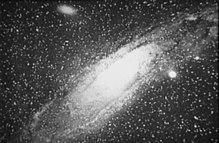

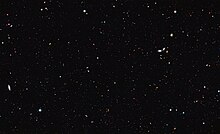

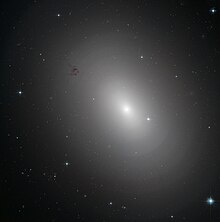

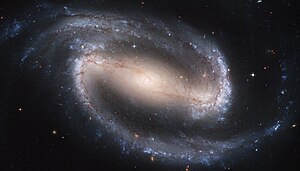
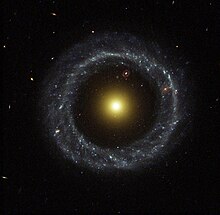


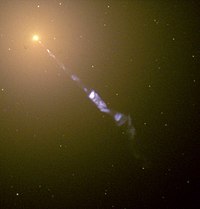
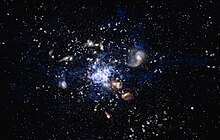
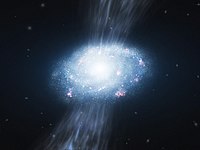



Thank you so much for this one
ردحذف